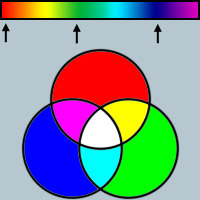
As you probably know... a given color of light can generally, be described by one number (e.g., the frequency of its wave length).
The color white, however, has no associated frequency; it is composed of equal amounts of all the (visible) frequencies of light. Black, of course, is the absence of light. And various shades of grey are generally composed of various intensities of white (as you lower the overall intensity of white, the grey gets darker and approaches black).
The question is: why is light (optically) additive? More specifically, why is it that when we add Red and Green together we get Yellow; Green and Blue together, we get Cyan; Red, Green, and Blue together, we get white?
(Please don't confuse this with the subtractive quality of pigments/paints, where as we add more colors, particularly more of the primary colors red, yellow, and blue, we approach black.)
Could we use three (or more) different colors and achieve the same result?
There is also something called the Land effect, which I believe is a higher brain function that interprets the colors we see in comparison to the overall background color. This is why a white shirt still looks white even if the color of the light changes. This effect isn't perfect, however, and if viewed in pure red light, the white shirt will look red.
I also recall hearing about an experiment in which photographs were taken through monochromatic filters. If the same scene was photographed with 2 different color filters, then the images were projected and superimposed, and then the test subject viewed the scene with 3-D glasses (one red lense, one green lense for example) then the scene would look normal with all the true colors. There was some specific wavelength (I assume related to the cones specific sensitifities) such that the 2 colors had to be one higher and one lower for the final picture to look right.
Land invented the polaroid camera, I believe.
|
|
Posted by Larry
on 2004-03-06 15:20:30 |
 As you probably know... a given color of light can generally, be described by one number (e.g., the frequency of its wave length).
As you probably know... a given color of light can generally, be described by one number (e.g., the frequency of its wave length).



